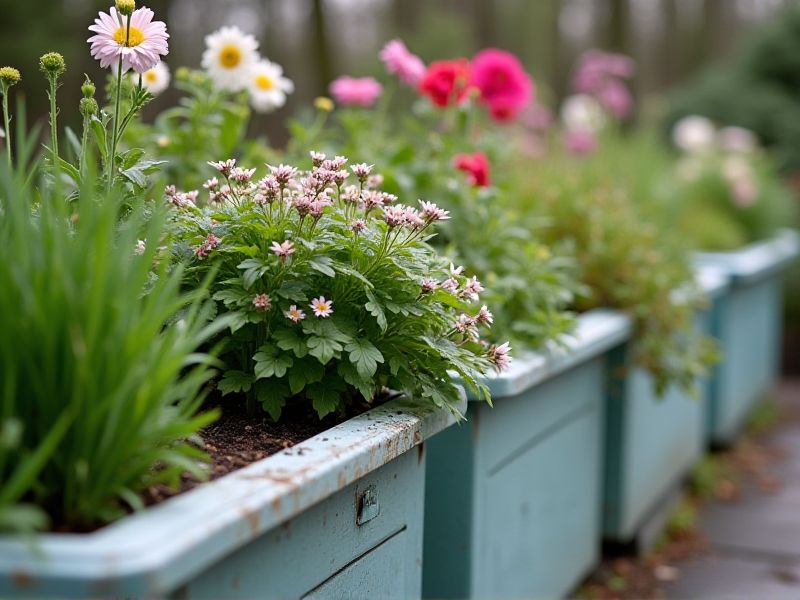
Surviving winter in container gardens requires selecting cold-hardy plants suited for your climate zone. Consider varieties like pansies, ornamental kale, and evergreen shrubs, which can withstand lower temperatures. To enhance winter survival, use insulated pots or wrap containers with materials like burlap or bubble wrap, reducing freeze-thaw cycles. Placing your containers in a sheltered location, such as near walls or under overhangs, can also protect them from harsh winds and extreme conditions. Regular moisture checks are critical, as container plants can dry out quickly even in winter; ensuring proper watering will help maintain their health throughout the season.
List of some Container plants that survive winter
- Boxwood (Buxus sempervirens)
- Japanese Yew (Taxus cuspidata)
- Coral Bells (Heuchera species)
- Hostas (Hosta species)
- Lavender (Lavandula angustifolia)
- Creeping Jenny (Lysimachia nummularia)
- Wintergreen (Gaultheria procumbens)
- Bergenia (Bergenia cordifolia)
- Ornamental Grass (Carex species)
- Ivy (Hedera helix)
Important things about Container plants that survive winter
Choose Hardy Plant Varieties
When selecting hardy plant varieties for container gardening that can withstand winter conditions, consider options like winter pansies, ornamental kale, and evergreens such as dwarf conifers. These plants thrive in colder temperatures and will maintain their vibrant colors and structures throughout the season. Ensuring that your container has adequate drainage is essential to prevent root rot under freezing conditions. By positioning your containers in sheltered spots, you can further enhance the survival rate of these robust botanicals during harsh winter months.
Use Proper Soil For Insulation
Choosing the right soil for container plants that survive winter is essential for their health and longevity. Opt for a high-quality potting mix that contains a blend of peat moss, perlite, and organic matter to ensure good drainage and moisture retention. Incorporating insulating materials, such as mulch or straw, on top of the soil can help regulate temperature and protect roots from freezing. Additionally, using containers made of insulating materials, like fiberglass or insulated ceramic, can further safeguard your plants from winter's harsh conditions.
Select Appropriate Containers
Container plants that thrive in winter offer a vibrant touch to your outdoor spaces during the colder months. Choosing hardy varieties such as ornamental kale, pansies, and winter jasmine can create stunning displays that withstand frost and snow. To protect your plants, ensure that your containers are made from insulated materials, like fiberglass or wood, which help regulate temperature. Remember to position your containers in sheltered spots, such as near walls or under eaves, to shield them from harsh winter winds and ensure better survival rates.
Implement Drainage Solutions
Container plants that survive winter require effective drainage solutions to prevent root rot and maintain plant health. To ensure proper drainage, consider using pots with drainage holes, or elevate containers slightly using pot feet. Incorporating a well-draining potting mix, such as one that includes perlite or sand, will enhance aeration and moisture control. You might also consider placing a layer of gravel or expanded clay at the bottom of your container to further improve water flow and prevent saturation during cold months.
Apply Mulch For Insulation
Mulching is an essential practice for insulating container plants during winter. Applying a layer of organic mulch, such as straw or shredded bark, helps regulate soil temperature and protects roots from freezing conditions. This insulation not only retains moisture but also prevents rapid temperature fluctuations, crucial for the survival of sensitive plants. To further enhance protection, consider placing your containers against a south-facing wall, where they can benefit from reflective heat while being sheltered from harsh winds.
Position Containers Strategically
Container plants that survive winter thrive with careful positioning in your outdoor space. Place them in sheltered areas, such as near walls or under eaves, to protect them from harsh winds and extreme temperatures. Opt for frost-resistant containers, like those made from ceramic or fiberglass, which help insulate roots against the cold. Consider using mulch or protective covers to retain moisture and further shield your plants from freezing conditions.
Water Adequately Before Freeze
Container plants that survive winter require adequate watering, especially before the temperatures drop and the ground freezes. Ensuring your plants are well-hydrated can significantly improve their resilience against cold weather and prevent root damage. Consider using insulating materials like burlap or bubble wrap around pots to protect them from extreme temperatures, while also allowing for sufficient drainage. Regularly check moisture levels throughout the winter months, as container plants may still need water even when the ground is frozen.
Monitor Weather Conditions
Container plants that survive winter thrive in cooler temperatures with proper care and protection. To ensure their resilience, it's crucial to monitor local weather conditions, as fluctuating temperatures can impact their health. Moving containers to sheltered locations, such as patios or against walls, can provide added insulation against harsh winds and frost. Regularly check moisture levels, as winter air can be dry, ensuring your container plants receive adequate hydration even during cold months.
Use Protective Coverings
Using protective coverings for container plants greatly enhances their chances of surviving winter. Insulating materials such as burlap, frost blankets, or bubble wrap can shield plants from harsh winds and extreme temperatures. Elevating containers off cold surfaces with plant stands or bricks helps prevent root freeze, while grouping pots together fosters a microclimate that retains warmth. By investing time in these protective measures, you can ensure your container plants thrive and rebound beautifully come spring.
Consider Bringing Indoors If Necessary
Container plants like pansies, ornamental cabbage, and evergreens can thrive through winter when properly cared for. Your choice of pots also plays a vital role; choosing insulated or ceramic containers helps protect roots from freezing temperatures. To enhance winter survival, position your containers in a sheltered spot, like near a wall or under an awning, where they receive some light but are shielded from harsh winds. Regular monitoring for moisture is crucial, as containers can dry out more quickly than garden beds during colder months.
